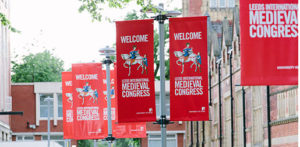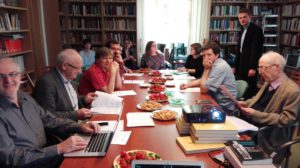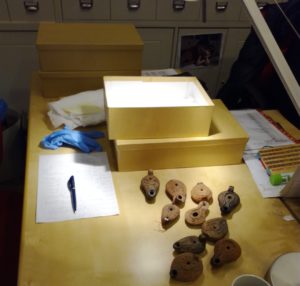Bryan Ward-Perkins and Robert Wiśniewski
 With over two thousand delegates attending, the IMC at Leeds is the largest and most international conference of medievalists in the world. We were therefore delighted to hold four sessions there, which both explored a central issue of our project with some young and some not-so-young experts in the subject, and showcased the diversity and range of the ‘Cult of Saints in Late Antiquity’. The issue we chose to focus on was ‘Marginal Saints’, the men and women of Late Antiquity and the Middle Ages who either just failed to be accepted as saints, or only just succeeded. Since there was no formal process of canonisation before the twelfth century, there were a substantial number of these ‘grey saints’, promoted with enthusiasm by their backers, but not necessarily with success. Examining them is interesting in itself, and also helps clarify the broad issues of what was expected of a saint, and the processes that were needed to manoeuvre him or her into a position of broad acceptance.
With over two thousand delegates attending, the IMC at Leeds is the largest and most international conference of medievalists in the world. We were therefore delighted to hold four sessions there, which both explored a central issue of our project with some young and some not-so-young experts in the subject, and showcased the diversity and range of the ‘Cult of Saints in Late Antiquity’. The issue we chose to focus on was ‘Marginal Saints’, the men and women of Late Antiquity and the Middle Ages who either just failed to be accepted as saints, or only just succeeded. Since there was no formal process of canonisation before the twelfth century, there were a substantial number of these ‘grey saints’, promoted with enthusiasm by their backers, but not necessarily with success. Examining them is interesting in itself, and also helps clarify the broad issues of what was expected of a saint, and the processes that were needed to manoeuvre him or her into a position of broad acceptance.
Our first session was entitled ‘The struggle to launch and maintain a cult’ and was opened by Bertrand Lançon, professor emeritus of the Université de Limoges. Professor Lançon introduced us to the ninth-century Actus of the bishops of Le Mans, with their remarkable attempt to establish the first (supposed) nine bishops of the see as saints, able to perform miracles – a claim that failed to take off, except in the case of the founder of the see, Julian. Pia Bockius, a doctoral student at the Freie Universität of Berlin, then gave us a full and accomplished overview of how Gregory of Tours (who wrote more about saints than any other writer of the early Middles Ages) approached sainthood and the establishment of cult – she rightly reminded us that not everything that Gregory wrote about saints was intended to encourage cult.
The second session was on ‘Unconventional sainthood’, with three speakers. Alan Thacker, of London’s Institute of Historical Research, introduced us to the many unnamed (but numbered) martyrs of Rome, men and women whose blood shed in quantity gave the city its uniquely high Christian status in the West. Estelle Cronnier, a researcher attached to the ‘Monde Byzantine’ centre in Paris, talked about Christian veneration of Old Testament patriarchs and prophets, which was a powerful feature of cult in the Holy Land and, more surprisingly, also in Constantinople. Finally, Abigail Steed, a doctoral student at Durham (who stepped in to fill a gap at the last minute), gave us an accomplished explanation of how the early-eleventh-century archbishop of Canterbury, Ælfheah, who was killed by his Danish captors in a moment of drunkenness rather than religious hatred, became a martyr in late Anglo-Saxon times and, thanks to some ingenious argumentation by Anselm of Bec, even remained a martyr into Norman times.
Our third session on ‘Failed saints’, again with three speakers, looked at people who nearly, but not quite, made it to be accepted as saints. The first presentation, by one of us (Bryan Ward-Perkins), was centred on the fascinating figure of Winnoc the Breton, an unfortunate whom Gregory of Tours seems initially to have believed to be a saint, but who then came spectacularly off the rails, descending into drunkenness and insanity. This was followed by a talk from David Defries, of Kansas State University, on the case of William Longsword, a tenth-century count of Normandy, who suffered political assassination, but for whom implausible efforts were made to present his death as that of a good Christian, struck down for his faith. Just as implausible, but in the long run much more successful, were the efforts of Eusebius, and of Constantine himself, to present this emperor as a saint, an equal indeed of the Apostles, which James Corke-Webster, of the University of Durham, presented as the final paper of the session. In the eastern church, Constantine crossed the barrier into sainthood; but he was never accepted in the same way in the West.
The fourth and final session of this ‘strand’, with two speakers, was under the playful title ‘Saints, but by a whisker’. Matthieu Pignot, of the Cult of Saints project, introduced us to Torpes of Pisa, a saint of exceptional obscurity in Late Antiquity, whose Martyrdom attributed his burial to an unknown place in Spain, but who somehow became popular in Carolingian times and later, even giving his name (if he is he is same saint!) to Saint Tropez on the French Riviera. Finally, Michel Kaplan, emeritus professor at the Sorbonne, spoke about Antony, archbishop of Thessaloniki, a staunch defender of icons who died in 843. Antony was acknowledged as a saint but only within the Life of another, much more successful figure, the nun Theodora, who attracted considerably more cult than Antony.
The individual talks hung together well, both speaking to each other and provoking a lively discussion of what made a saint and what made a successful cult. Next year’s IMC conference will be centred on the theme of ‘Memory’, which is of course a central feature of the cult of saints – we will be there, and are already planning the themes of the individual sessions!




